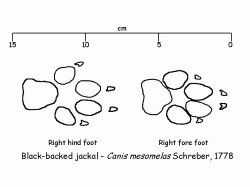Black-backed jackal Canis mesomelas (Schreber, 1778)
.tmb-medium.jpg?sfvrsn=f9d06220_1)
Photo: Quinette Kruger
Kingdom: Animalia
Phylum: Chordata
Class: Mammalia
Order: Carnivora
Family: Canidae
Genus: Canis
Species: mesomelas

The black-backed refers to the broad, dark saddle, extending from its neck to the base of the tail. The head, flanks, and limbs of adults are a rich reddish colour - rooijakkals (= Afrikaans). The black-backed jackal exhibits both diurnal and nocturnal activity; the circadian activity pattern closely resembling that of their important prey animals, particularly rodents.
They are one of the few mammalian species with a long-term monogamous pair bond; both the male and female take part in the rearing of the young. Mated pairs are territorial and both males and females mark (urine) and defend the boundaries of their territory. The home ranges of the adult pairs are mutually exclusive. However, when a large prey carcass becomes available, they will tolerate neighbours joining in the feast.
Food is regurgitated when the pups are young; later, food is carried in the mouth and left to be eaten by the pups inside or near the entrance of their den. Pups (helpers) from the previous year's litter help with the rearing; regurgitating food for the litter and the lactating mother, and guarding the pups while their parents are absent foraging for food, thereby increasing the survival rate of the pups.
The black-backed jackal is clearly omnivorous; eating insects, carrion, warm-blooded prey, and vegetable matter. They are opportunistic, taking whatever prey is in greatest abundance or is the easiest to capture.
In South Africa, predation by black-backed jackals [and caracals Caracal caracal] impact severely on the livestock industries, especially sheep and goat farmers.
Typical of canis, black-backed jackals have the following dental formula:
3 1 4 2
I – C – P – M – = 42
3 1 4 3
Literature
Skinner, J.D. and Smithers, R.H.N., 1990. The Mammals of the Southern African subregion. University of Pretoria, South Africa.
For more information on this predator species, refer to the information leaflets on the Predation Management Centre (PMC's) Predators and predation webpage.